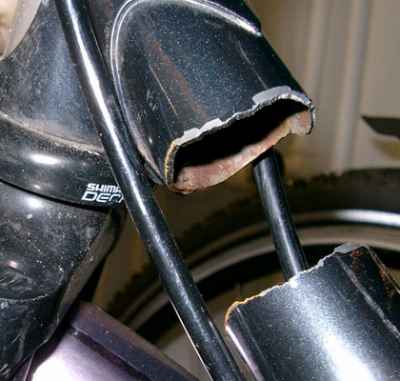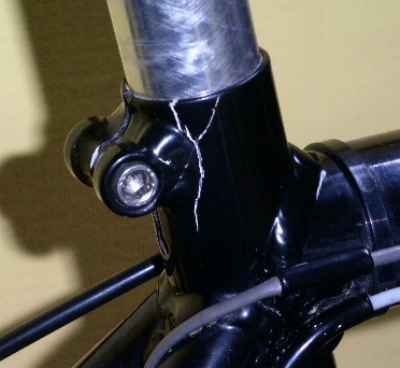 |
This
is a crank
which after years of faithfull service has had enough. Cracks are
growing
from the sharp corners of the internal square, here visible at 3 and 6
o'clock. Time to order a new crankset, and no heavy sprinting please. |
 |
The
accompanying
righthand crank has also suffered: the crankarm is trying to part
company
from the spider. Again a crack has started on a sharp corner in a
heavily
stressed area. |
 |
200
engineering
textbooks can't be wrong! This is what happens when you incorporate all
stressraisers known to mankind in a single dynamically loaded part.
Maybe
the designer thought the part wouldn't know where to start failing
first
for all the possibilities! The other side: 
Photo's
courtesy
of Bert L:am
|
 |
Crack
in the
righthand crank. A notch caused by a dropped chain has nothing to with
it, as demonstrated by the lefthand crank:  |
 |
Could
we please
go back to oldfashioned spindles with external flats? Here 's an axle
with
an internal 8mm hexagonal in the threaded end. That doesn't leave much
meat. The result is two cracks originating from the points of the
hexagon,
straight through the threads
Removal
was
a bear, as the force of the allan-key expands the thread! (solved it by
chucking the axle in the lathe) Removal of this kind of pedal on the
chainwheelside is a risky
business anyhow, you won't be the first needing stitches
|
 |
Broken
bracket-axle
from a spinning bike.
A
spinning
bike doesn't see any rain, so the bearings will last indefinitely. This
isn't true for the axle, certainly when the axle meets with a very hard
steel crank. With a steel crank the stresstransition is much more
severe,
and it looks as the axle snapped just where the crankbolt ended.
Spinning bikes can't move from side to side, which must make things
hrder on the crank too.
The
crack clearly
started in the lower half. The continuing motion has polished the
crack-surface
until the remaining section grew so small it failed. The fresh failure
zone is course.
(picture
courtesy
Marten Hoffmann)
|
 |
This
is the
shell of an XT rearhub (freehubside) The bearings are well lubricated,
judging by the grease coming out of the crack! The 5 YO hub has done
about
15.000 km's worth of commuting and loaded touring. Crack corresponds
with
the start of the innerflange which is very thick because it has to
support
the freehub. |
 |
This
is what
an overloaded QR axle looks like. The previously round hole has
elongated
and the sides show serious necking. It is always a good idea to
lubricate
the skewer, with less friction there is more clamping force available,
and you get a better idea what you're up to |
 |
A
handlebar
with severe deformation in the clamping area. In fact the deformation
was
so severe that the bars kept rotating. Excessive tightening, an aero
bar
and a large hole in the barclamp (see the bulge) were probably
contributing
factors.
Replace
at
once! |
 |
With
a carbon
bar a spill will have far reaching effects. I've never seen a alloy bar
crack here, the norm being that you can at least finish the race |
 |
There
are many
ways to stop a bike! See here the downtube-headtube junction in a
filletbrazed
frame which met with a solid object. The downtube sprouts a double chin
(yes, that stubble is cracked clearcoat), and the forkrake suffered a
lot
too. With a new fork this frame is probably good for another few
thousand
miles, but it won't handle like new. And keep your eyes peeled for the
start of a crack in this area. |
 |
Expensive
Koga's
are not immune from problems, and the guarantee didn't extend to the
second
owner!
The
crack has
started from the sharp point of the bottom lug. From the rust at the
bottom
section you see it has been awhile and the crack could possible have
been
spotted before total collapse. The crack took some time untill the
remaining
section couldn't handle the strain and snapped.
(picture
courtesy
Niels Alsemgeest)
|
 |
The
rivnut
(bottlecage mounting) is being pulled through the frame. Not very
threathening
in this stage, unless the crack starts growing in another direction and
then things will happen fast! |
 |
A
waste of
a fresh powdercoat-job. This side is the final crack, the tear starting
on the left side. From the looks of it, it has been there for quite
some
time. This frame was probably around 25 years old. |
 |
Rear
dropout
with the mudguards mount nearly fallen off. The spotwelded protrusion
wasn't
meant to take a fully loaded rack |
 |
This
is an
expensive frame but luckily with a guarantee*). The crack started on
the
left side in the heat-affected zone. The tear looks a bit oxidised, and
not as bright as the final crack on the right. Also note the cracks in
the clearcoat (picture on the left) which show that the tube has
deformed
as it broke.
*)
replaced
in a week
pictures
courtesy
Franke Nieuwenhuis
|
 |
The
government
health surgeon has determined that pressing on regardless when the
chain
has caught between chainring and chainstay
is detrimental to your -aluminium- frame's life! Here's a
fatiguecrack
which not accidentally coincides with a deep dent. This won't last a
single
hard race. |
 |
A
very thin
Tange Prestige doesn't like chainsuck at all either. Pity the painter
didn't
spot this before applying a thick coat of bondo. |
 |
Another
crack
in an aluminium rear triangle. This one starts in the thick weld
attaching the bridge to the chainstay (dee insert)
|
 |
Small
racing
accident, this is a cracked wishbone. The droplets are water, leaking
out
through the crack. Frame had to be replaced, the funny sized glued-in
wishbone
wasn't available: $$$$ ! |
 |
Not
a bike
but it is Reynolds 531! This is a 40 year old subframe from a well-used
Jaguar E-type Cracks start around the stiffener/ suspension mounting
point. |
 |
Again
a guaranteejob,
this time the toptube has started to part from the seattube on this
alumnium
MTB. The seattube is unaffected, which points to a defective weld. Too
short a seatpost (or a short adapter sleeve) (*) could give similar
problems,
but then the crack usually starts at the rear or from the sides.
(Photo
courtesy
Bert Lam)
(*)
Seat post
or sleeve should be inserted at least 2 cm below the toptube
|
 |
Another
demonstration
of why loose non-welded seatclamps are popular. The stressconcentration
at the junction of the hefty lump to the thin walled tube in the heat
affected
zone was a bit to much.
Fixed
under
guarantee by welding up the crack, replacing the clamp with a
non-welded
version and repaint
(Photo
courtesy
Chris Leurs)
|
 |
Rather
embarrasing
if this clamp breaks during a ride, but easily replaced with a sturdier
version with more meat where it counts |
 |
Cracked
carbon
steerer. Probably due to insufficient support by the plug, I'd rather
see
a full tubular style here. But a fancy cutaway stem wasn't helpfull
either.
I try
to fit
stems on carbon steerers with a 5mm shim on top of the stem, which
should
move some of the clamping force away from the edge. |
 |
See
here the
forkcrown of an only 5 holidays old Giant Expedition.The stiff
boxsections
of the crownhalves are welded to a flexible (thinwalled & large
diameter)
steerertube. This ensures that the welds are higly stressed. The
undercutting
(^) in the steerertube, where the weld goes round the corner
gives
this poor design the kiss of death. I would hate to ride this fork much
further, the fork will probably collapse if you have to make an
emergencystop. |
 |
The
welder
has cut through the seatrail, creating a notch. This stressraiser does
as can be expected |
 |
Double
eyeletted
Mavic which cried enough after 3000 km's. The rim stayed true
enough
to finish the trip but you can see straight through! Rim was advertized
as featuring 'bomb proof strenght' and a for best use of
'heavy
loads'. |
 |
Another
cracked
rim, but you can't really blame it. Some cycleshop had managed to build
it with straight gauge #13 spokes (aka telegraph poles) at 150 kgs of
tension.
Massive overtensioned spokes without give do not build into a reliable
wheel. You'll never break a spoke again sir, indeed! |

|
And
yet another one
|
 |
This
is a spokenipple
of a Mavic Ksiruim SSC rim. The nipple is threaded into the rim and
cannot
move. With a heavy sprinter the spoke will now have to bend at the
exit:
The nipple has cracked open and the aluminium spoke has sheared in
two |
 |
Unless
you're
into watchrepairs I suggest you leave a STI shifter wll alone. No
spares
are available, so try to get a failed shifter warrantied first! Note
the
broken sintered? parts |